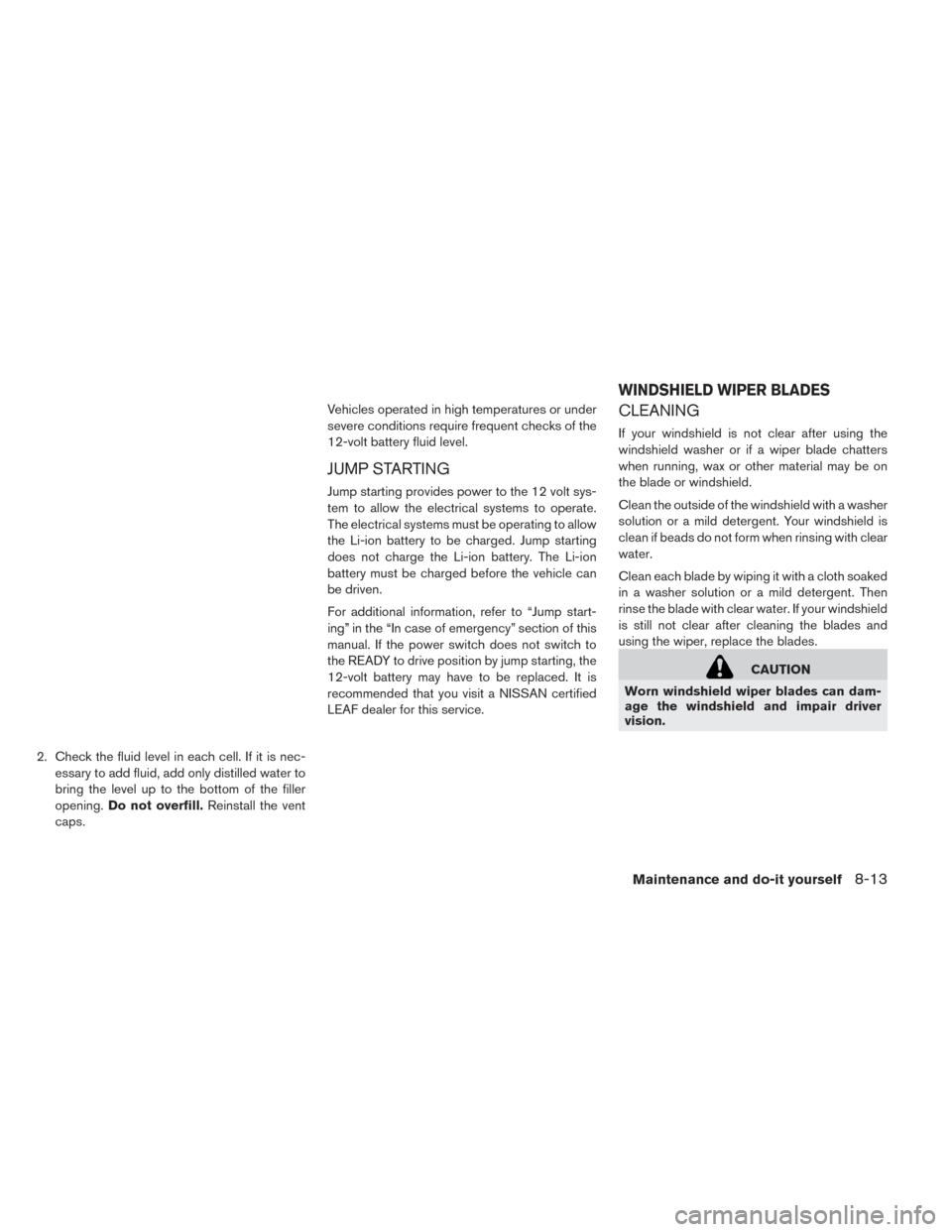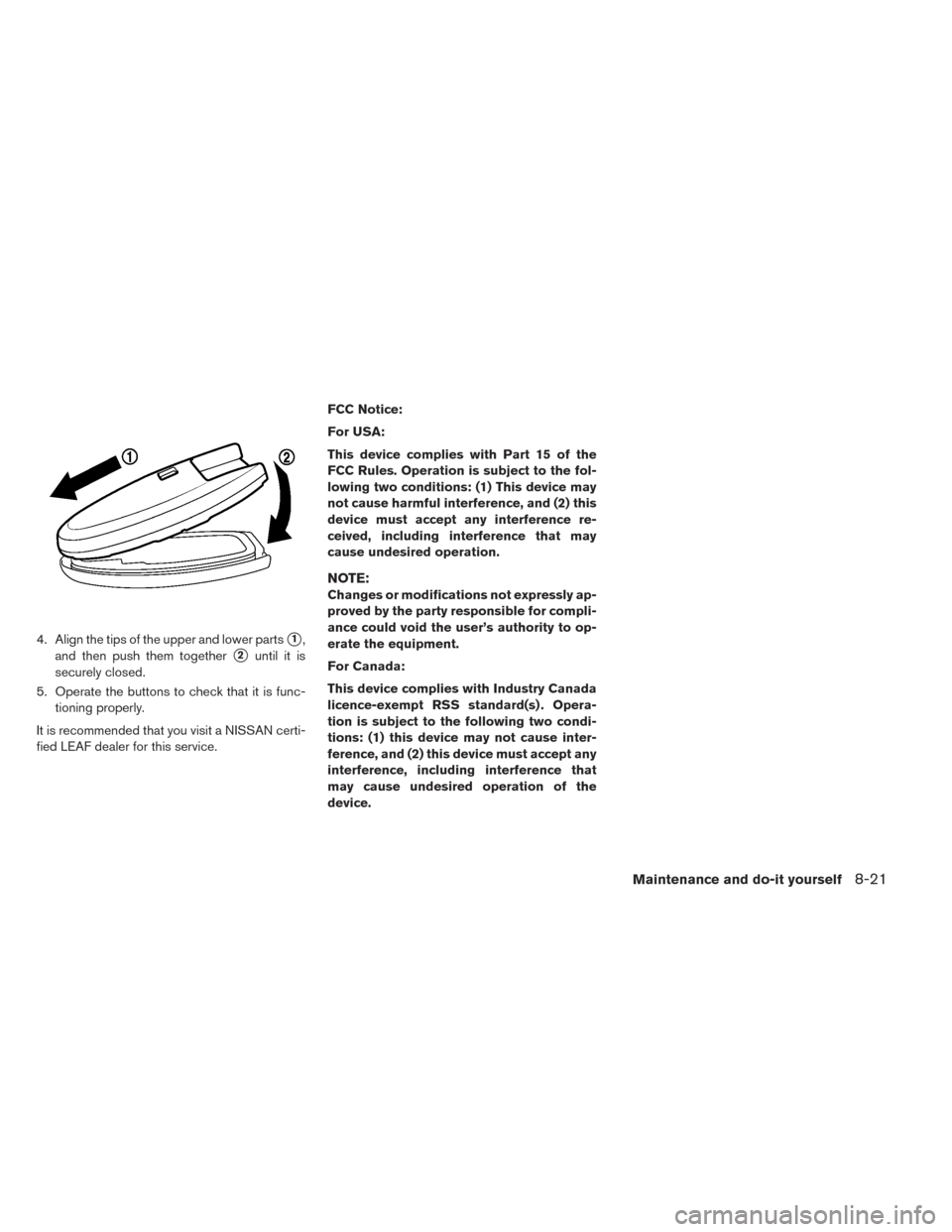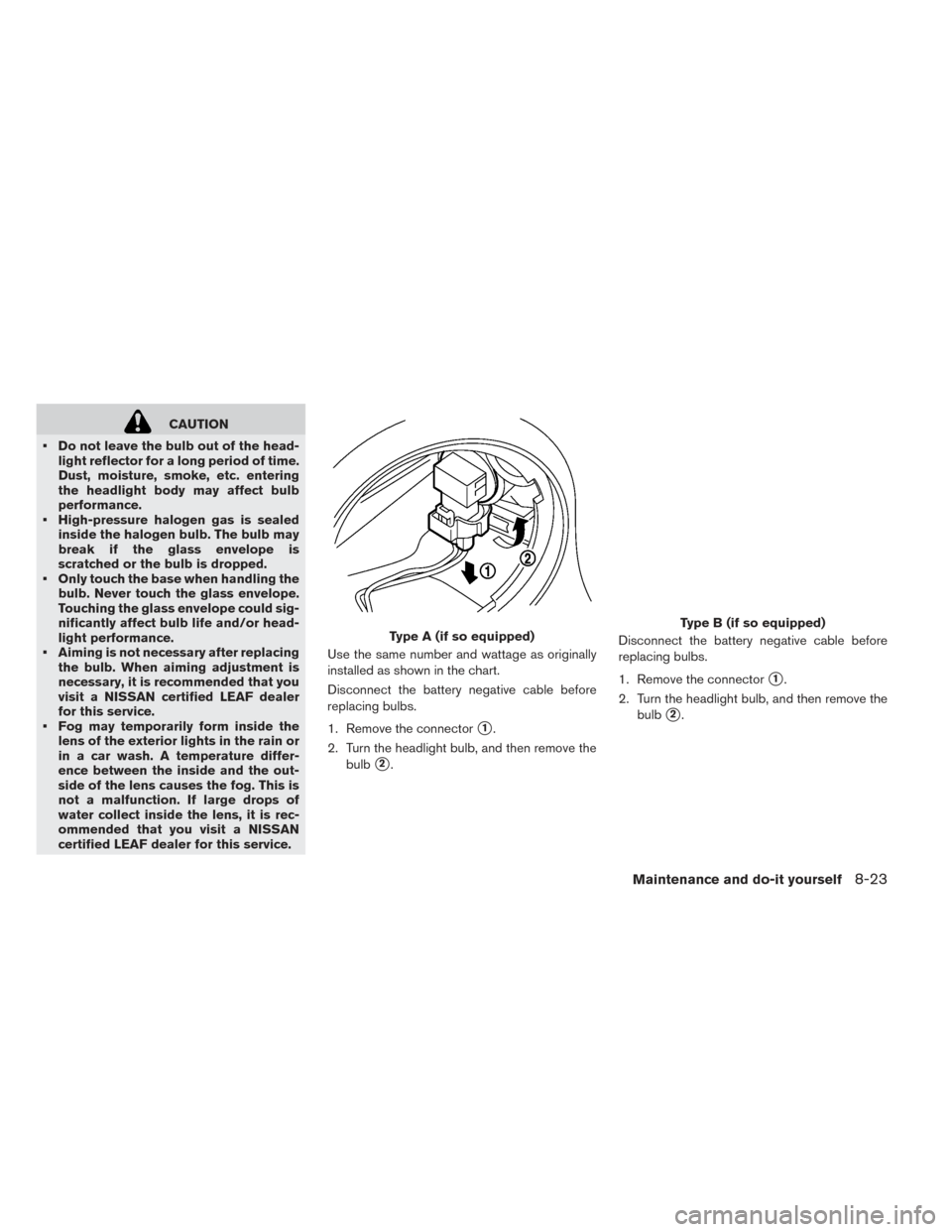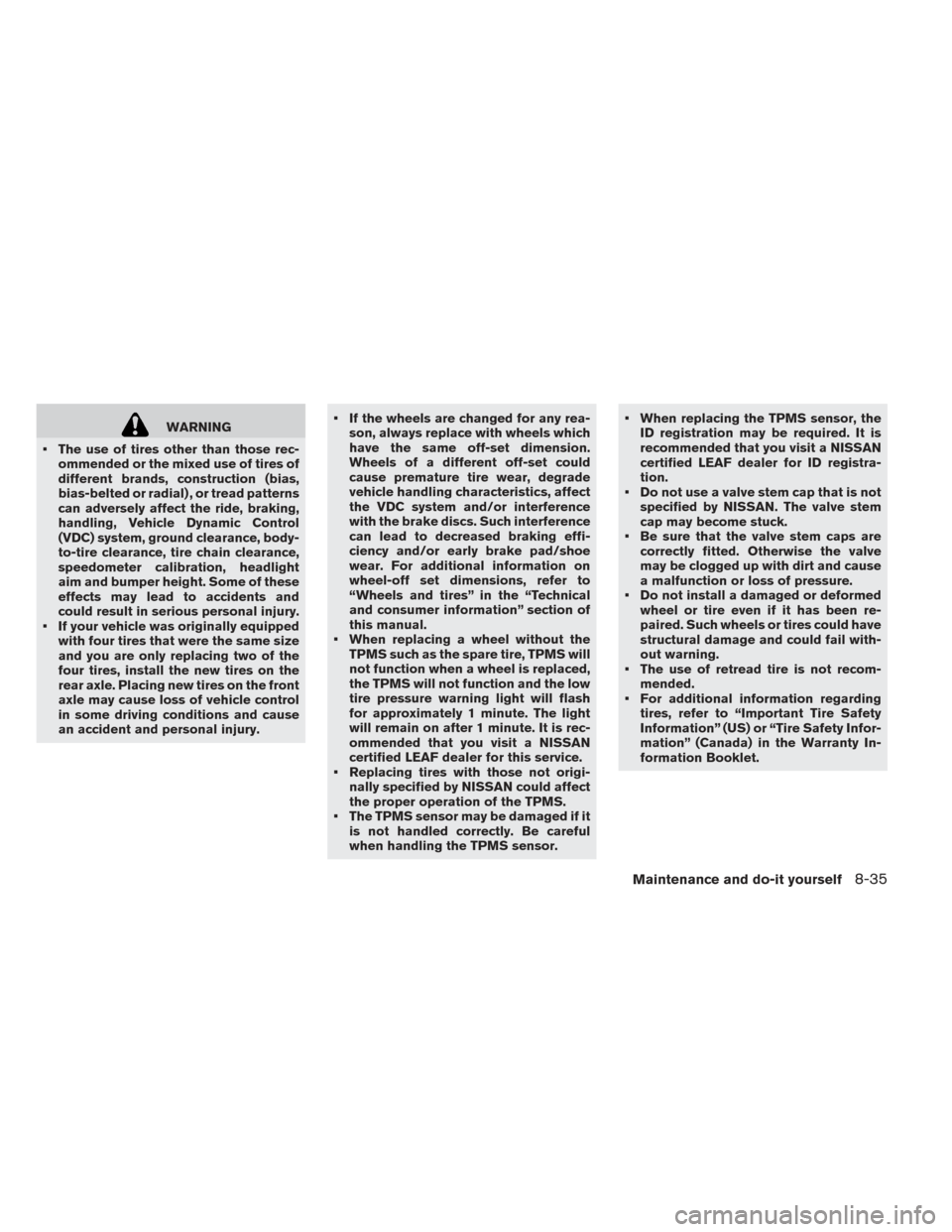Page 370 of 424

2. Check the fluid level in each cell. If it is nec-essary to add fluid, add only distilled water to
bring the level up to the bottom of the filler
opening. Do not overfill. Reinstall the vent
caps. Vehicles operated in high temperatures or under
severe conditions require frequent checks of the
12-volt battery fluid level.
JUMP STARTING
Jump starting provides power to the 12 volt sys-
tem to allow the electrical systems to operate.
The electrical systems must be operating to allow
the Li-ion battery to be charged. Jump starting
does not charge the Li-ion battery. The Li-ion
battery must be charged before the vehicle can
be driven.
For additional information, refer to “Jump start-
ing” in the “In case of emergency” section of this
manual. If the power switch does not switch to
the READY to drive position by jump starting, the
12-volt battery may have to be replaced. It is
recommended that you visit a NISSAN certified
LEAF dealer for this service.
CLEANING
If your windshield is not clear after using the
windshield washer or if a wiper blade chatters
when running, wax or other material may be on
the blade or windshield.
Clean the outside of the windshield with a washer
solution or a mild detergent. Your windshield is
clean if beads do not form when rinsing with clear
water.
Clean each blade by wiping it with a cloth soaked
in a washer solution or a mild detergent. Then
rinse the blade with clear water. If your windshield
is still not clear after cleaning the blades and
using the wiper, replace the blades.
CAUTION
Worn windshield wiper blades can dam-
age the windshield and impair driver
vision.
WINDSHIELD WIPER BLADES
Maintenance and do-it yourself8-13
Page 373 of 424

REAR WINDOW WIPER BLADE
It is recommended that you visit a NISSAN certi-
fied LEAF dealer if checking or replacement is
required.If the brakes do not operate properly, have the
brakes checked. It is recommended that you visit
a NISSAN certified LEAF dealer for this service.
WARNING
Do not adjust the height of the brake
pedal. Doing so could alter the effective-
ness of the brakes, which could result in a
serious accident and personal injury. If
adjustment is required, it is recom-
mended that you visit a NISSAN certified
LEAF dealer for this service.
BRAKE PAD WEAR WARNING
The disc brake pads have audible wear warnings.
When a brake pad requires replacement, it will
make a high pitched scraping sound when the
vehicle is in motion. This scraping sound will first
occur only when the brake pedal is depressed.
After more wear of the brake pad, the sound will
always be heard even if the brake pedal is not
depressed. Have the brakes checked as soon as
possible if the wear warning sound is heard.
Under some driving or climate conditions, occa-
sional brake squeak, squeal or other noise may
be heard. Occasional brake noise during light to
moderate stops is normal and does not affect the
function or performance of the brake system.
Proper brake inspection intervals should
be followed. For additional information, refer to
the maintenance log section of your NISSAN
Service and Maintenance Guide.
BRAKES
8-16Maintenance and do-it yourself
Page 375 of 424
6. If the fuse is open�A, replace it with a new
fuse
�B.
7. If a new fuse also opens, have the electrical system checked, and if necessary, repaired. It
is recommended that you visit a NISSAN cer-
tified LEAF dealer for this service.Fusible links
If any electrical equipment does not operate and
the fuses are in good condition, check the fusible
links in the holders
�1,�2and�3. If any of these
fusible links are melted, replace only with Genu-
ine NISSAN parts. For checking and replacing the fusible links in the
holders
�1,�2and�3, it is recommended that
you visit a NISSAN certified LEAF dealer for this
service.
8-18Maintenance and do-it yourself
Page 376 of 424
PASSENGER COMPARTMENT
WARNING
Never use a fuse of a higher or lower
amperage rating than that specified on
the fuse box cover. This could damage
the electrical system or electronic control
units or cause a fire.
If any electrical equipment does not operate,
check for an open fuse.
1. Make sure that the power switch and the headlight switch are turned off. 2. Insert a screwdriver wrapped with the cloth
�Cinto the slit�1.
Use a cloth
�Cto protect the fuse box cover.
3. Then pull to remove the fuse box cover
�2.
4. Remove the fuse with the fuse puller
�3. 5. If the fuse is open
�A, replace it with a new
fuse
�B.
6. If a new fuse also opens, have the electrical system checked, and if necessary repaired. It
is recommended that you visit a by a NISSAN
certified LEAF dealer for this service.
Maintenance and do-it yourself8-19
Page 378 of 424

4. Align the tips of the upper and lower parts�1,
and then push them together
�2until it is
securely closed.
5. Operate the buttons to check that it is func- tioning properly.
It is recommended that you visit a NISSAN certi-
fied LEAF dealer for this service. FCC Notice:
For USA:
This device complies with Part 15 of the
FCC Rules. Operation is subject to the fol-
lowing two conditions: (1) This device may
not cause harmful interference, and (2) this
device must accept any interference re-
ceived, including interference that may
cause undesired operation.
NOTE:
Changes or modifications not expressly ap-
proved by the party responsible for compli-
ance could void the user’s authority to op-
erate the equipment.
For Canada:
This device complies with Industry Canada
licence-exempt RSS standard(s) . Opera-
tion is subject to the following two condi-
tions: (1) this device may not cause inter-
ference, and (2) this device must accept any
interference, including interference that
may cause undesired operation of the
device.
Maintenance and do-it yourself8-21
Page 379 of 424
1. Headlight assembly
2. Map light
3. Room light
4. High-mounted stop light
5. Rear combination light
6. Cargo light
7. License plate light
8. Side marker light
9. Fog light (if so equipped)
Fog may temporarily form inside the lens of the
exterior lights in the rain or in a car wash. A
temperature difference between the inside and
the outside of the lens causes the fog. This is not
a malfunction. If large drops of water collect
inside the lens, it is recommended that you visit a
NISSAN certified LEAF dealer for this service.
HEADLIGHTS
For additional information on headlight bulb re-
placement refer to the instructions outlined in this
section.
Replacing
Halogen headlight (high-beam):
The headlight high-beam is a semi-sealed beam
type that uses a replaceable headlight (halogen)
bulb.
LIGHTS
8-22Maintenance and do-it yourself
Page 380 of 424

CAUTION
• Do not leave the bulb out of the head- light reflector for a long period of time.
Dust, moisture, smoke, etc. entering
the headlight body may affect bulb
performance.
• High-pressure halogen gas is sealed inside the halogen bulb. The bulb may
break if the glass envelope is
scratched or the bulb is dropped.
• Only touch the base when handling the bulb. Never touch the glass envelope.
Touching the glass envelope could sig-
nificantly affect bulb life and/or head-
light performance.
• Aiming is not necessary after replacing the bulb. When aiming adjustment is
necessary, it is recommended that you
visit a NISSAN certified LEAF dealer
for this service.
• Fog may temporarily form inside the lens of the exterior lights in the rain or
in a car wash. A temperature differ-
ence between the inside and the out-
side of the lens causes the fog. This is
not a malfunction. If large drops of
water collect inside the lens, it is rec-
ommended that you visit a NISSAN
certified LEAF dealer for this service. Use the same number and wattage as originally
installed as shown in the chart.
Disconnect the battery negative cable before
replacing bulbs.
1. Remove the connector
�1.
2. Turn the headlight bulb, and then remove the bulb
�2. Disconnect the battery negative cable before
replacing bulbs.
1. Remove the connector
�1.
2. Turn the headlight bulb, and then remove the bulb
�2.
Type A (if so equipped)Type B (if so equipped)
Maintenance and do-it yourself8-23
Page 392 of 424

WARNING
• The use of tires other than those rec- ommended or the mixed use of tires of
different brands, construction (bias,
bias-belted or radial) , or tread patterns
can adversely affect the ride, braking,
handling, Vehicle Dynamic Control
(VDC) system, ground clearance, body-
to-tire clearance, tire chain clearance,
speedometer calibration, headlight
aim and bumper height. Some of these
effects may lead to accidents and
could result in serious personal injury.
• If your vehicle was originally equipped with four tires that were the same size
and you are only replacing two of the
four tires, install the new tires on the
rear axle. Placing new tires on the front
axle may cause loss of vehicle control
in some driving conditions and cause
an accident and personal injury. • If the wheels are changed for any rea-
son, always replace with wheels which
have the same off-set dimension.
Wheels of a different off-set could
cause premature tire wear, degrade
vehicle handling characteristics, affect
the VDC system and/or interference
with the brake discs. Such interference
can lead to decreased braking effi-
ciency and/or early brake pad/shoe
wear. For additional information on
wheel-off set dimensions, refer to
“Wheels and tires” in the “Technical
and consumer information” section of
this manual.
• When replacing a wheel without the TPMS such as the spare tire, TPMS will
not function when a wheel is replaced,
the TPMS will not function and the low
tire pressure warning light will flash
for approximately 1 minute. The light
will remain on after 1 minute. It is rec-
ommended that you visit a NISSAN
certified LEAF dealer for this service.
• Replacing tires with those not origi- nally specified by NISSAN could affect
the proper operation of the TPMS.
• The TPMS sensor may be damaged if it is not handled correctly. Be careful
when handling the TPMS sensor. • When replacing the TPMS sensor, the
ID registration may be required. It is
recommended that you visit a NISSAN
certified LEAF dealer for ID registra-
tion.
• Do not use a valve stem cap that is not specified by NISSAN. The valve stem
cap may become stuck.
• Be sure that the valve stem caps are correctly fitted. Otherwise the valve
may be clogged up with dirt and cause
a malfunction or loss of pressure.
• Do not install a damaged or deformed wheel or tire even if it has been re-
paired. Such wheels or tires could have
structural damage and could fail with-
out warning.
• The use of retread tire is not recom- mended.
• For additional information regarding tires, refer to “Important Tire Safety
Information” (US) or “Tire Safety Infor-
mation” (Canada) in the Warranty In-
formation Booklet.
Maintenance and do-it yourself8-35